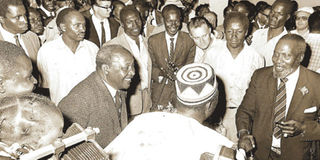Premium
Tears and blood as Big 2 face off

President Jomo Kenyatta (right) and opposition Kenya Peoples Union leaderJaramogi Oginga confront each other in Kisumu on October 25, 1969. Eleven people were killed in riots that ensued. PHOTO | FILE
Eleven people were killed and scores of others injured during riots in Kisumu following a confrontation between President Jomo Kenyatta and opposition leader Jaramogi Oginga Odinga.
Kenyatta had gone to the lakeside town to open the Russian-built provincial hospital when he was confronted by Odinga and his Kenya Peoples Union supporters.
Political events in the build-up to the tragedy had soured relations between the two freedom fighters and their Kikuyu and Luo communities.
Odinga, Kenyatta’s first vice-president, had formed the Kenya Peoples Union (KPU) after being kicked out of Kanu in 1966. His party had seven MPs in Nyanza. And three months earlier, Tom Mboya, the urbane popular Luo politican, had been assassinated in Nairobi. These had turned Kisumu and Nyanza generally into an opposition stronghold.
On that Saturday, the Kenyatta motorcade rolled into Kisumu from Webuye, where he had opened the Pan Paper Mills, at about 3.30pm. When Kenyatta arrived at the hospital grounds, a crowd police estimated to number about 5,000 was waiting.
As he was inspecting a guard of honour, a section of the restless crowd started shouting, “Dume! Dume! Dume!”. It was the KPU slogan. The sloganeering continued as the President went to sit and even as he read his speech.
It was after the speech that Kenyatta and Odinga had an open and heated altercation. Kenyatta asked Odinga why he was misbehaving, yet he was his friend. Odinga reminded Kenyatta that he had fought for his release from detention, yet he had turned against him.
Kenyatta taunted Odinga about his communist leanings. Odinga responded by telling Kenyatta that he was now “eating with the very West” who had sent him to prison.
As things heated up, Kenyatta’s security quickly ushered him into his vehicle, which drove out of the grounds. As he left, hostile crowds started stoning his motorcade and police shot at them indiscriminately.
Mr Bernard Njinu, the presidential escort commander, described the situation as the most trying in his career. Kenya@50 caught up with Mr Njinu, who had later become Kenya’s third commissioner of police.
Speaking for the first time in 43 years the British-trained policeman said: “As commander, my main concern was the safety of the president. Not even the army was in charge of the president’s security at that time. I was in charge and had to ensure that he left the venue safely.” Mr Njinu is now a farmer in Kiambu.
As Kenyatta left the venue, police in the escort lead car opened fire along the road to scare away surging crowds. In the stampede and shooting, 11 people died — four children, five adults, and two policemen.
After Kenyatta left, a 6 pm to 6 am curfew was imposed in Kisumu town. It lasted two weeks.
Kenyatta, who was touring western Kenya for the first time since independence, did not return there until his death on August 22, 1978.
He ruled the country from his home in Gatundu and State House Nakuru, Nairobi, and Mombasa.
The incident marked the return of detention without trial and suppression of political dissent that was to haunt Kenya for the next two decades.
Three days later, Odinga and his deputy, Mr JM Nthula, who was MP for Iveti South, were put under house arrest.
Other KPU MPs and officials were also placed under house arrest. They were Achieng Oneko, the KPU publicity secretary, MPs Luke Obok (Alego), Tom Okello-Odongo (Kisumu Rural), Okuto Bala (Nyando), Odero Sar (Ugenya), Wasonga Sijeyo (Gem), and Ondieki Chilo of Nyakach. Also detained was the only woman, Caroline Okello-Odongo, Odinga’s secretary, who was the wife of the Kisumu Rural MP.
On October 30, 1969, the government banned KPU. It issued a gazette notice declaring that since its formation (1966), the party had become “more subversive both in its nature and in its objectives.”
KPU and all its branches were declared “dangerous to the good government of the Republic of Kenya.”
Kenyan students in Moscow violently demonstrated at the Kenyan embassy, injuring the ambassador, David Kayanda, with an iron bar.




